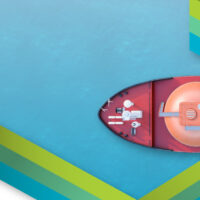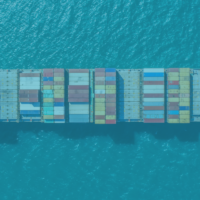The Voluntary Protection Zone implemented to keep commercial ships at a safe distance from the west coast of Haida Gwaii is extended.
A collaborative effort by First Nations, the federal government and the marine shipping industry is protecting the culturally and ecologically sensitive coastline around Haida Gwaii from oil spills due to maritime commercial incidents and accidents. The agreement to establish a Voluntary Protection Zone (VPZ) on Canada’s Pacific Coast represents a significant accomplishment for the shipping industry on the road toward reconciliation with Indigenous Peoples in Canada.
Analysis of the results of a 14-month trial of the VPZ conducted by the Council of the Haida Nation (CHN) Marine Planning Program team showed that 89 per cent of ships stayed outside the designated “keep out” zone off the west coast of Haida Gwaii. As of November 1, 2021, the duration of the VPZ has been extended to ensure protective measures remain in place while the project committee explores long-term options for preserving Haida Gwaii’s fragile coastline from the potential impacts of marine shipping activities. Such impacts could include pollution caused by shipping containers falling overboard – a risk highlighted by the M/V Zim Kingston incident that occurred just a week before the VPZ was renewed. Risks were further highlighted when the Champion Concept, carrying canola oil, lost power a few days later west of the archipelago and had to be towed to port.
A protection measure aimed at large commercial ships
Since 2019, the Council of the Haida Nation, Transport Canada (TC) and the marine shipping industry have worked together to establish the terms of the VPZ and guide its implementation. The measure asks commercial vessels weighing 500 gross tonnes or more – such as bulk carriers or container ships – to stay more than 50 nautical miles (nm) from the west coast of Haida Gwaii with some exceptions. Vessels travelling between ports in the Pacific Northwest are asked to observe a minimum 25 nm distance, while cruise ships are allowed to come as close as 12 nm. Tugs and barges are exempt. Oil tanker traffic near Haida Gwaii has been restricted since 1985 through the voluntary tanker exclusion zone and the more recent oil tanker moratorium.
The Haida Nation had recommended a 50 nm minimum shipping protection zone based on the results of the vessel drift and response analysis of the Pacific region conducted by Clear Seas and Nuka Research. The CHN sought an additional layer of protection in the wake of an incident in 2014 when the Russian cargo ship Simushir lost power in stormy seas and came close to running aground on the archipelago. The Canadian Coast Guard held the drifting ship away from shore until it could be towed to safety.

Source: Haida Gwaii Voluntary Protection Zone Project Committee
Collaborating to help protect the coast
In an email response about the future of the agreement, TC noted that collaboration between the CHN, the Government of Canada, and marine shipping industry associations has been essential in reducing the risk of accidents on the west coast of Haida Gwaii. “This trial has fostered the building of productive relationships, collective learning and mutual understanding between participants,” a representative said. “Since the launch of the trial, we have been observing a declining trend in the number of vessels transiting inside the VPZ each month.”
Transport Canada noted that this work supports the CHN in protecting Haida Gwaii from pollution because of ship breakdowns and accidents. The trial is a step towards accomplishing the Council’s recommendation of establishing a safe distance offshore for vessels, a result from the 2015 Lessons from the Simushir workshop.
The agreement was part of a collaborative governance structure established in the Reconciliation Framework Agreement for Bioregional Oceans Management and Protection (RFA) and is part of Canada’s Oceans Protection Plan.
Stephanie Hewson, a staff lawyer with West Coast Environmental Law, says that the VPZ is important for the protection of the coast of Haida Gwaii. “The Voluntary Protection Zone protects an area of high ecological and cultural value off the coast of Haida Gwaii: several Marine Protected Areas (MPAs) have been established in the area, and these and other recently identified areas are anticipated to form an integral part of Canada’s first MPA Network.”

Hewson says that the region is vulnerable to ships running aground and the possibility of oil spills. “It is critical that vessels transit a safe distance offshore. Through Haida leadership and the support of Transport Canada and industry, the VPZ has been a successful first step towards addressing these concerns. For this success to continue, it’s important that the VPZ be permanently established in law, for example through legislation or an internationally recognized designation,” she says.
The need for a permanent measure
So, what does the future hold for the VPZ? One option is to follow the example of Washington State’s Olympic Coast National Marine Sanctuary that has enjoyed permanent internationally recognized protection as an International Maritime Organization designated Area to be Avoided since 1994. As climate change makes extreme weather events along the Pacific coast more frequent, the need for permanent measures to reduce the risk of pollution from shipping is only likely to increase.



